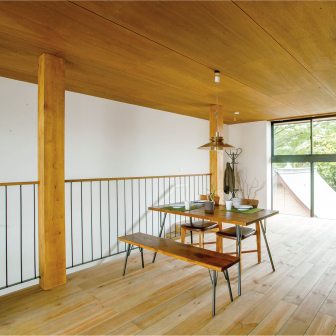What We Can Realize
1. Strong and Beautiful Wooden Structural Frames with Unlimited Potential
When it comes to the strength of a wooden structure, it is not the timber itself but also the strength of the joints and structural surfaces such as walls, floors, and roofing that are crucial. As a result, the aseismic capability largely depends on the joints and structural surfaces. Traditional wooden architecture, with no alternative but to increase the number of walls and columns in order to ensure aseismic capability, imposed challenges that resulted in significantly restricted planning options. By strengthening the joints, STROOG connectors can reduce the number of walls and columns required. Furthermore, in combination with other types of connectors such as connectors for pin joins, Rahmen joins, or free angled joins, they improve the flexibility of planning exponentially. Wooden structural frames released from these restrictions can realize large spaces and wide openings which were traditionally difficult to realize.
Auditorium with a large space and wide opening realized in wooden architecture / Yayoi Auditorium Annex of the University of Tokyo
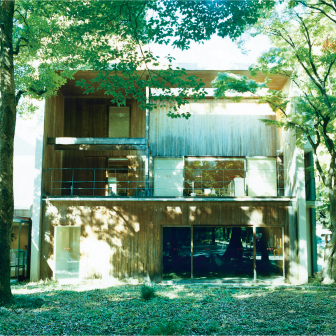
2. Accommodating Various Usages and Scales from Residences to Schools
STROOG products enable wooden architecture to be planned for various usages. We have diverse installation examples from residential houses which realized the requests of owners and designers while maintaining sufficient aseismic capability, to a wooden town hall making use of local timber, and a kindergarten building highlighting the warmth of timber. We have also supported a variety of building scales such as a built-in garage for a narrow space and a 4-story city residence.
Small-scale one-story residential house featuring a unique roof shape / TSUI NO SUMIKA
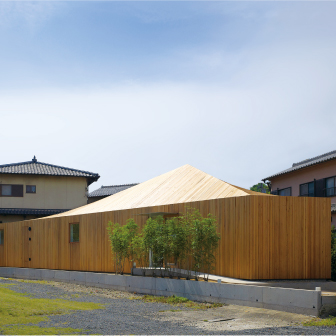
3. Diversity of Wooden Structural Frames
Rahmen joints and pin joints can be mixed within a frame. We enable various types of structural frames to suit your planning. These include multi-layered Rahmen, consecutive Rahmen, single-sided Rahmen, Rahmen to construct voids, Rahmen for columnar walls, joint Rahmen, trusses and others. Aside from basic continued-column Rahmen, we also support continued-beam Rahmen and allow for the flexible placement of columns over different building floors. As they can be used with panel bearing walls and/or braced bearing walls, the placement of Rahmen frames can be limited only to necessary positions, which allows flexible and cost-effective planning.
Mid to large-scale wooden architecture utilizing locally produced timber / Newly-built Sumita Town Hall
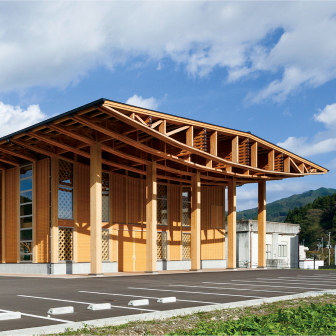
4. Accommodating Various Types of Timber and Mixed Structures
Aside from various sizes and types of timber, STROOG products can accommodate mixed structures of timber and non-timber (RC or steel) construction. They enable flexible options that take designability and cost into account. For example, a primarily wooden building comprising a ground floor with RC structures, second and third floors with wooden structures, and some steel columns installed.
Mixed structure building that comprises wooden structures inserted into steel structures / House of 33 Years
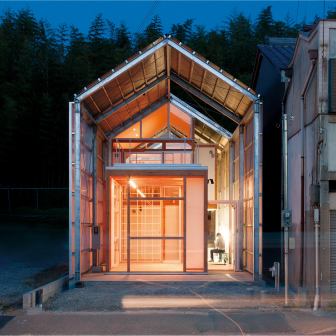
5. Large Spaces and Large Spans
Unlike common wooden architecture, we enable joints to resist seismic force without requiring panel bearing walls or braced bearing walls, which allows for the planning of large spaces and large spans. We have realized not only a large living space without any partition walls or columns, but also a kindergarten building with an over 9m span, and another example with a large space formed by a 20m span configured with trusses.
Open space with an over 9m span realized in wooden architecture / Tokyo Yurikago Kindergarten
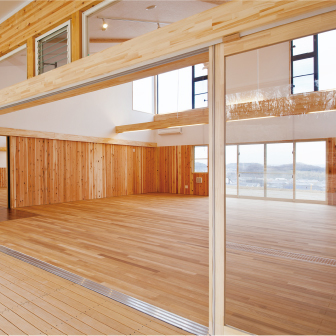
6. Wide Openings
As with large spaces and spans, we also enable wide openings which have been difficult in common wooden architecture. We allow planning for buildings with a full opening which has no walls on one side as well as buildings with wide openings on all four sides, which creates a connected feeling to the outdoor space, a spacious view, and an open and bright internal space.
Steel-like construction with one side full opening realized in wooden structure / O house
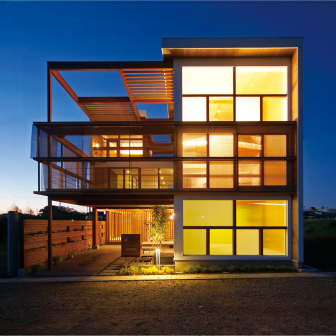
7. Overhangs and Cantilevers
We enable overhanging structures where the upper tier hangs over the lower tier allowing utilization of the space below. We also have capabilities for cantilevered structures allowing planning for cantilevered balconies and eaves.
2.4m overhang realized in a wooden house / KA
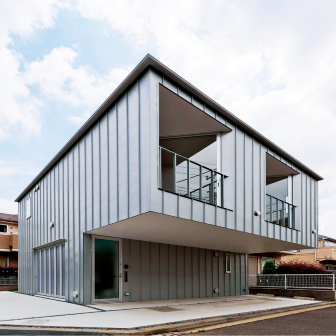
8. Voids, Climbing Beams, Unconstrained Ceiling Height and Roof Shape
High bearing-force horizontal structural surfaces enable large voids. We can also verify safety of the building based on the size of the void by conducting a structural calculation through advanced 3D frame analysis. We can realize three-dimensionally open spaces, high ceilings across two stories, wide staircases, and attic spaces formed by climbing beams. Aside from gable roofs, hipped roofs, deck roofs, and other complex roof shapes are also possible.
House with one side full opening and three-story void / House in Gotokuji
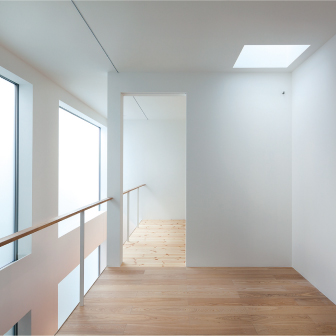
9. Skip-Floors and Utilization of Rooftops
We also realize skip-floors while supporting safety verification through a structural calculation reflecting the difference in the floor levels. STROOG products were adopted in a residential house that comprised seven layers in different levels. In addition, we enable rooftop spaces to be utilized, meeting the needs of houses built in narrow places.
Skip-floors and exposed structure / KMC
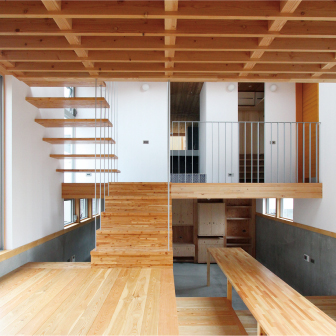
10. Alteration of Usage and Layout
We also support skeleton-infill housing which facilitate changing the usage, layout and internals of the house by separating an aseismic structural body referred to as a “skeleton” and the internals or “infill”. With STROOG connectors designed to facilitate future renovations and expansions, you can leverage the advantage of skeleton-infill housing which accommodates changing lifestyles and families, and maintains the property value.
Rooftop space creating a connected feeling to indoor space / Uehara O
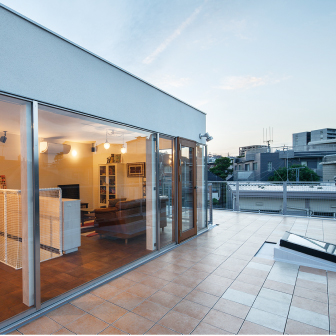
11. Converting Steel or Reinforced Concrete Constructions into Wooden Architecture
Building designs originally planned as steel or reinforced concrete constructions can be converted to wooden architecture planning which has great cost efficiency and lower environmental impact. By using wood that absorbs CO2 to grow for a building, the CO2 can be trapped inside the building components. Therefore, wooden architecture is also environmentally friendly.
Mid to large-scale wooden building used as a training and accommodation facility / Shishu-Kan Graduate School at Kyoto University
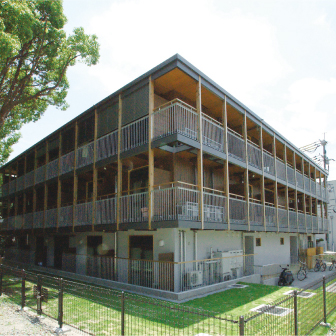
12. Exposed Structure Presenting Wooden Textures
STROOG connectors are designed to realize exposed wooden structures. They can be hidden inside the timber to keep the beauty intact. Allowing for the use of sacrificial timber, they realize wooden architecture presenting wooden textures even where fire safety regulations are applied and even for mid to large-scale buildings.
Exposed structure realized throughout the house and columns with sacrificial timber capabilities / Suganomori hare terrace
